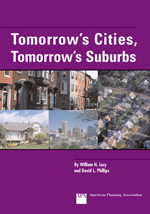June 02, 2009 Categories: Reviews
Tomorrow’s Cities, Tomorrow’s Suburbs
William H. Lucy and David L. Phillips
2006. Planners Press. 354 pp. $55.95
Data hounds will enjoy this book; the rest of us can dig out some interesting thoughts. The two big points are that areas with housing built before 1940 seem to be doing better (pre-recession) than areas with housing built in more recent decades up to 1990, and that a case can be made that sprawl-type areas are less safe than inner cities. (The first point has more evidence behind it than the second.) If you haven’t kept up with the literature, the authors give thumbnail summaries and comments on ten recent viewpoints from prominent folks writing about these matters, including David Rusk, Anthony Downs, Bruce Katz, Myron Orfield, Andres Duany, and Peter Calthorpe.

The authors organize the book around a puzzle: old housing is not “trickling down” in the way it used to, with poorer people moving increasingly into aging neighborhoods. A nationwide trend toward some older neighborhoods booming has been going on since the 1990s. Why? No new federal policies comparable to the New Deal or the interstate highway system or anti-poverty measures have been put in place. The authors think that some beliefs about the safety of cities have changed, and that the small middle-aged houses of the 1950s are lacking in market appeal.
That lack matters, because people can afford to move a lot, and do so. “The economic status of each local jurisdiction is persistently in jeopardy. With an average metropolitan residential mobility rate in five years of 45 to 50 percent between 1995 and 2000, as well as from 1985 to 1990 and from 1975 to 1980, the character and quality of local jurisdictions can change substantially within a decade or less. Each local government, therefore, is subject to market tests about its attractiveness….” {23} Economists tend to think of home buyers shopping among jurisdictions for marginal differences in policy; the idea that they’re catching on to the merits of older construction seems plausible.
Lucy and Phillips could have rattled some windows if they had foregrounded some of their policy ideas. For instance, generations of planners have sought the holy grail of regional government; outside of Portland, Oregon, they have been disappointed and likely will continue to be. The authors suggest that they would probably be disappointed anyway: “More regional land-use planning will not hurt, but planning without implementation will not help. Interlocal revenue sharing, where it has occurred (Minneapolis-St. Paul, Hackensack, and Charlottesville-Albermarle), has reduced fiscal disparities, which is important, but it has not limited sprawl or reduced poverty concentrations. Affordable housing in new developments would need to be a substantial percentage of new housing for many years to have much impact on concentrated poverty” — and it goes without saying (by them, anyway) that no regional government with the power to impose justice on wealthy suburbs is likely to be born. {36}
Another potential window-rattler is the authors’ calculations relating traffic fatalities plus murders to density of population. In the Chicago metropolitan area, for instance, the city itself has a combined rate of 1.3 traffic fatalities and homicides by strangers per 10,000 people. Exurban counties Grundy and Kendall (the latter best known as the home of former US House Speaker Dennis Hastert) have much higher combined rates of 2.5 and 2.1 respectively. Other suburban counties such as DeKalb, McHenry, and Will are comparable to the city of Chicago; suburban Lake and DuPage counties are a bit lower. The authors unfold all the data, so you can also take the same kind of glance at metropolitan Baltimore, Cincinnati, Cleveland, Dallas, Houston, Milwaukee, Minneapolis, Philadelphia, and Pittsburgh. To the extent that this idea makes it into mainstream thought, the suburbs may be in even more trouble. The authors do contribute five additional reasons (again, pre-recession) why cities may continue to make gains on suburbs.
The book has little to say about design, but the authors are obviously thinking about it. Their final paragraph includes this statement: “Planning and design that create quality places where people want to be may be as or more important than public policies.” {336} To the drawing boards!
#
